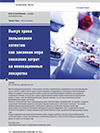Redemption of the Right to Use a Patent as a Legal Measure to Reduce the Cost of Innovative Drugs
DOI: 10.33917/es-4.162.2019.120-125
Many innovative drugs used in key therapeutic areas and in such diseases like cancer, hepatitis C, diabetes and many others are an integral part of state insurance programs and reimbursement schemes. Meanwhile, often due to the high cost of medicines and budget constraints, the need of all patients requiring treatment cannot be satisfied. This problem is extremely relevant both in industrialized countries, such as the USA, Great Britain, France, Germany and in such relatively young pharmaceutical markets like Russia. In many countries, there is a law on redemption of patent rights from manufacturers, which allows the state subsequently to provide patients with the necessary therapy almost at the drug’s cost price. However, this practice is not widespread and is really used in isolated instances, even in the leading world countries. The purpose of the present article is to substantiate the need for broad application of the scheme of the patent use redemption by the state using the example of drugs for treating hepatitis C in the USA, where this law has been functioning for many years. During the study, we analyzed the works of leading foreign authors in the field of pharmaceuticals and patent protection, as well as legislative and regulatory documents, statistical materials of international databases on the industry over the past years
References:
|
1. Centers for Medicare & Medicaid Services. On its 50th anniversary, more than 55 million Americans covered by Medicare, available at: URL: https:// www.cms .gov/Newsroom/MediaReleaseDatabase/Press-releases/2015-Press-releases-items/2015-07-28.html. 2. OECD Health Statistics’2015, WHO Global Health Expenditure Database, available at: http://www.oecd-ilibrary.org. 3. Henry J. The Medicare Part D prescription drug benefit. Kaiser Family Foundation, 2015, available at: http://files.kff.org/attachment/medicare-prescriptiondrug-benefit-fact-sheet. 4. Paradise J. Medicaid moving forward. Kaiser Commission on Medicaid and the Uninsured. 2015, available at: https://www.kff.org/health-reform/issuebrief/medicaid-moving-forward/ 5. Wasserman E. Medicaid drug spending hike riles lawmakers, but there’s no end in sight. Fierce-Pharma. 2015, available at: http://www.fiercepharma.com/story/medicaid-drugspending-hikes-rile-lawmakerstheres-no-end-sight/2015-04-13. 6. Brennan T., Shrank W. New expensive treatments for hepatitis C infection. JAMA, 2014, no 312(6), pp. 593–594. 7. Barua S., Greenwald R., Grebely J. Restrictions for Medicaid reimbursement of sofosbuvir for the treatment of hepatitis C virus infection in the United States. Ann Intern Med, 2015, no 163(3), pp. 215–223. 8. DiMasi J., Grabowski H., Hansen R. Innovation in the pharmaceutical industry. new estimates of R&D costs. Health Economics, 2016, no 47, pp. 20–33. 9. Kesselheim A., Avorn J. Biomedical patents and the public’s health: is there a role for eminent domain? JAMA, 2006, no 295(4), pp. 434–437. 10. Denniston M., Jiles R. Chronic hepatitis C virus infection in the United States, National Health and Nutrition Examination Survey 2003 to 2010. Ann Intern Med, 2014, no 160(5), pp. 293–300. 11. Martin A., Hartman M., Benson J., Catlin A. National Health Expenditure Accounts Team. National health spending in 2014: faster growth driven by coverage expansion and prescription drug spending. Health Affairs, 2016, no 35(1), pp. 150–160. 12. Hill A., Khoo S., Fortunak J., Simmons B., Ford N. Minimum costs for producing hepatitis C direct acting antivirals, for use in large-scale treatment access programs in developing countries. Clin Infect Dis, 2014, no 58(7), pp. 928–936. 13. US Senate Committee on Finance. The price of Sovaldi and its impact on the U.S. health care system, 2015, December, available at: http://www.finance.senate.gov/imo/media/doc/1%20The%20Price%20of%20Sovaldi%20and%20Its%20Impact%20on%20the%20U.S.%20Health%20Care%20System%20(Full%20Report).pdf 14. IMS Health (MIDAS), 2016, April, available at: www.ims.com. 15. Love J. Non-voluntary use of patents for drugs to treat the hepatitis C virus in the United States: mechanisms available to the federal government, state governments and private actors, Knowledge Ecology International, 2014, July, available at: http://keionline.org/sites/default/files/Non-voluntary_use_HCV_patents_USA.pdf. |



